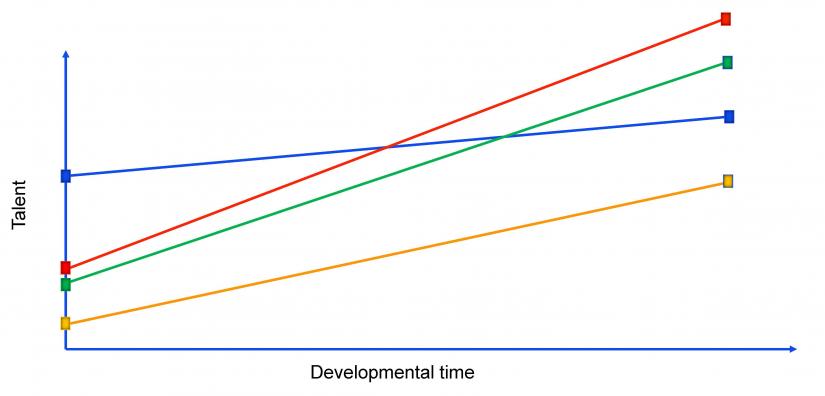
Source: Pixabay
Couldn't make it to the Community Information Session on Youth Sport at the Human Performance Research Centre? You can view the presentation online.
Where does talent come from? Can it be learnt or is it something we’re born with? Skill acquisition expert Dr Job Fransen explains that before we can answer these questions, we first need to distinguish between giftedness and talent.
Giftedness is when an individual belongs to the top 10% with certain natural abilities, while a talent relates to the 10% of individuals who have specific characteristics in a specific domain.
The process of honing a gift into a talent isn’t as simple as it is thought to be. Terman’s study of the gifted proved that gifted intelligence doesn’t directly correlate with ongoing success. This means, a child who displays excellence in their early sporting years will not necessarily go on to become an elite athlete. Equally, a child who has not been outstanding in their early years but has passed a certain ‘giftedness threshold’ may still have the potential for success if their talent is nurtured under the right constraints.
So how do we help develop talent? Dr Job Fransen believes that our understanding of talent development can be formulated by investigating the following questions.
Does talent exist?
Talent is far more complex than originally thought.
Dr Fransen explains, “Talent is an intricate relationship between the environment, the individual and the task.”
For example, a child’s natural abilities, her exposure to competitive sports from a young age, and her focused training with a coach, will all have an impact on the development of her talent in a particular domain.
Failing to consider the interrelationships of these factors will limit the potential to nurture talent.

Talent exists, but its conceptualisation is far more complex than we imagined.
Is future potential predictable?
When looking back on David Beckham’s achievements, it is easy to say that the moment he won the under 15s “best player” award, he was bound for success. But what about the children who also received awards in the under 15s and didn’t go on to achieve the same success?
There are many factors which affect whether someone achieves excellence in sport. Some are measurable, such as growth or relative age, and others can’t be quantified, like chance or opportunity.
Do talent identification and development programs work?
There is evidence to support the theory that talent identification (TID) and development programs do work, but not in the way we thought.
Research by Anne Güllich states, “[that] the earlier a child is selected into a development program, the earlier they’ll leave.”
Early achievement is related to reaching success more quickly at a junior level but with a reduced likelihood of attaining senior success. Evidence shows that international level athletes compared to the national counterparts entered high-level development programs at a later age.
For TID and development programs to work, there needs to be a constant influx of new players to counter the constant rate of players who leave due to loss of interest or injury.
Is talent multifactorial?
Talent is a combination of multiple personal attributes working together harmoniously. As children develop at different ages and in different ways, many need to compensate for their weaknesses by exploiting strength in other areas.
For example, a youth soccer player who hasn’t matured as quickly as his peers may need to compensate by developing their skills in speed or agility.
“Many practitioners would argue that youth players who show some weaknesses should be deselected. Instead, practitioners should be focusing on how these athletes are trying to overcome these weaknesses, and whether that will eventually give them a performance advantage in the future,” says Dr Fransen.
Is talent development more important than talent identification?
Talent identification is not about understanding who is best right now, but rather who can develop their gifts or talents into future achievements.

Talent development is more important than talent identification: intercepts and slopes.
As shown in the graph, when measuring the likely success of four athletes at the first particular time point, it seems that the blue athlete is most likely to succeed. However, if you follow them through their developmental years, over time the differences in original ability are negated by how well they develop. This highlights that talent development is equally or more important than talent identification.
“Often, those individuals cannot be identified using a one-off measurement at an early age, making it important to introduce as many individuals as possible to talent development programs to maintain healthy talent pools,” says Dr Job Fransen.
What can practitioners do?
Talent cannot be taught from scratch, but it can be nurtured.
Dr Fransen says that in order to nurture talent in youth athletes a constraints-led approach to skill acquisition is needed. This kind of approach requires practitioners to emphasise self-discovery and to use a ‘hands-off’ attitude, and when put into practice, a constraints-led approach has the ability to capture the complexity and ever-changing dynamics of youth sport.
To learn more about talent development in youth sport, watch Dr Job Fransen’s presentation on Skill Acquisition in Youth Sport:
Part 1 – Talent Identification and Development: A quest for the Holy Grail?

